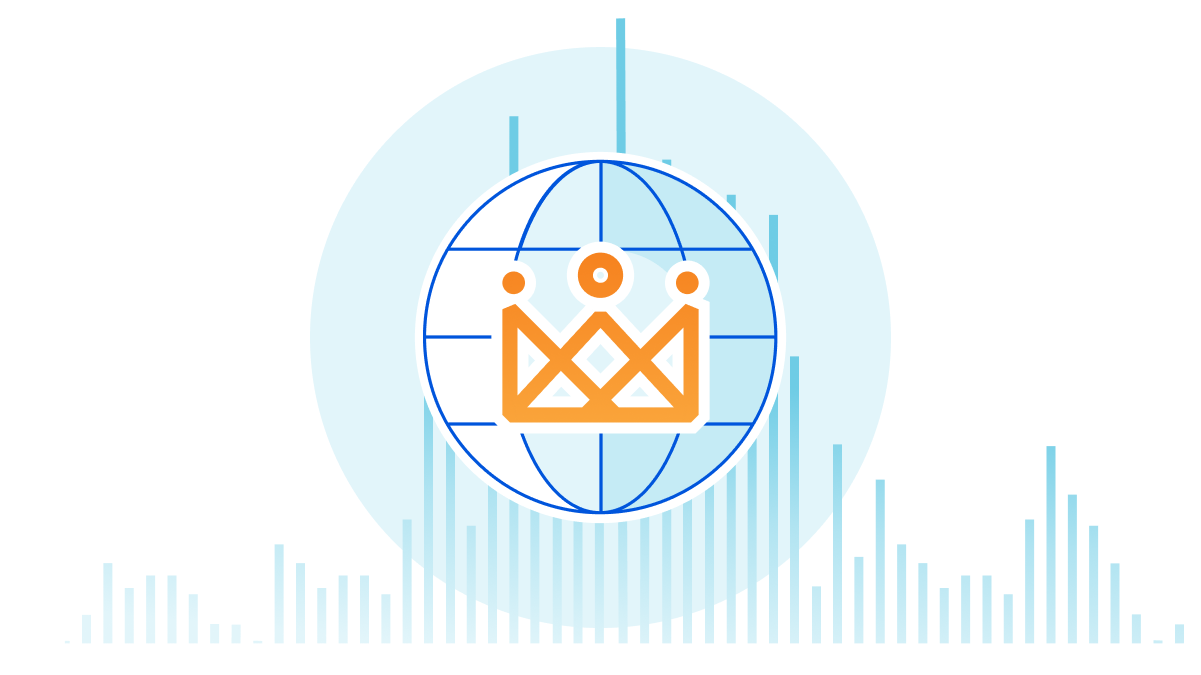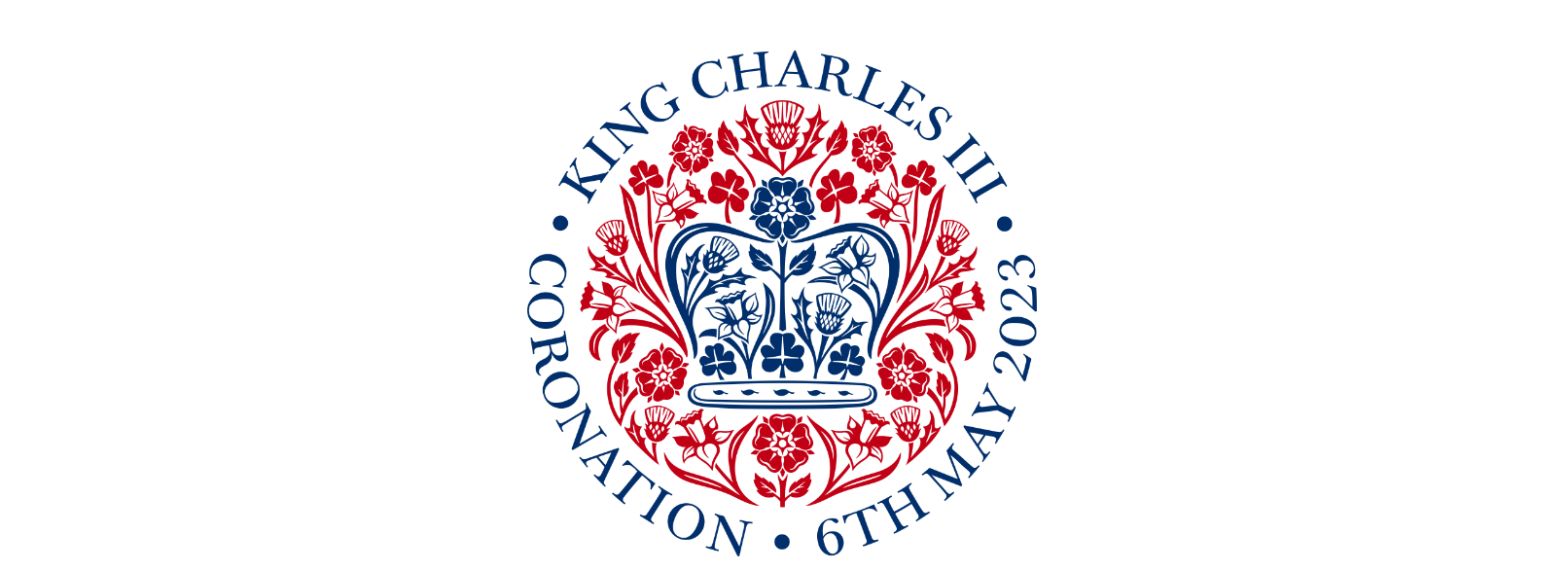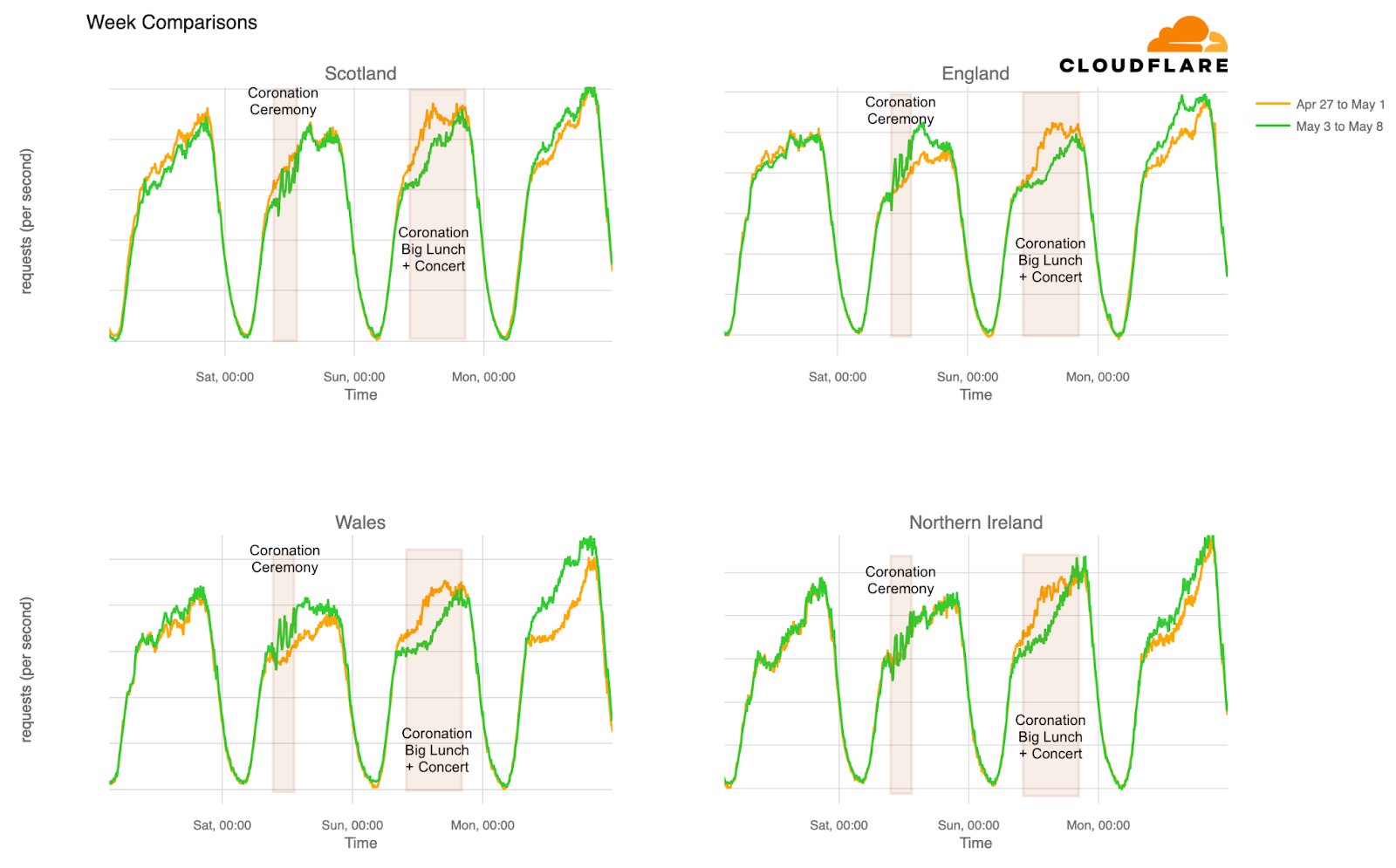
When major events in a country happen Internet traffic patterns are often impacted, depending on the type of event. But what about the coronation of a king or queen? There’s no similar precedent, with a worldwide impact, in the Internet age, except maybe the coronation of the king of Thailand, in 2019. The last time it happened in the United Kingdom was 70 years ago (June 2, 1953), with Queen Elizabeth II; it was the first British coronation to be fully televised. Neither the Internet nor ARPANET were around at the time.
Imagine a grand royal event (if you saw the broadcast or the news, there’s no need), filled with pomp and pageantry, that's so captivating it impacts Internet traffic. That's what happened during the coronation of Charles III and Camilla, the newly crowned king and queen of the United Kingdom and other Commonwealth realms. As the coronation ceremony unfolded, on Saturday morning, May 6, 2023, there were clear spikes and dips in traffic, each coinciding with key moments of the ceremony.
Then came Sunday, and with it, the Coronation Big Lunch event. As the nation sat down to enjoy a communal meal throughout the country, Internet traffic took a significant nosedive, dropping by as much as 18%. The Sunday trends didn't stop there. As night fell and Prince William took to the stage to deliver a speech during the Coronation Concert, there was a clear drop in Internet traffic. Monday, May 8, was a bank holiday in the UK in honor of the coronation, and after a weekend of outdoor coronation events, Internet traffic was buzzing, noticeably higher than usual.
In the past, we’ve seen Internet traffic drop when a national televised event is happening — last year, we saw it, including in the UK, during the Eurovision, although traffic does increase when results are in. Different types of events and broadcasts yield different Internet patterns.

Coronation day: a rollercoaster of Internet traffic
Let's take a closer look at coronation day, May 6, 2023, when Internet traffic in the UK had its own peaks and valleys. There were moments when the digital realm seemed to hold its breath, with traffic dipping to its lowest points. The arrival of the royals and their guests marked one such moment. As the anticipation built and all eyes turned to the grand entrances, Internet traffic dipped to a notable 7% lower than the previous week.
Here's a play-by-play of the day's traffic trends, compared to the previous week. We’re using a 15-minute granularity, and aligning with key events as reported live by the BBC:
Traffic decreases (Saturday, May 6, 2023)
| Rank by drop (compared with previous week) | Coronation events (from the BBC) |
|---|---|
| #1 — 10:45-11:00 local time (-7% in traffic) | When the royals and guests were arriving at Westminster Abbey. The King and Queen arrived at 11:00. |
| #2 — 12:00 (-2%) | When King Charles III (12:02) was crowned. |
| #3 — 13:00 (-3%) | When King Charles and Queen Camilla left Westminster Abbey. The Coronation Procession started. |
On Saturday, May 6, 2023, a downward trend in traffic began after 06:15, with traffic 5% lower than the previous week. This trend shifted to a traffic increase after 11:15 (+6%), coinciding with the ongoing ceremony. The exceptions were the previously mentioned traffic dips. The following table illustrates clear traffic spikes after significant moments, some of which are represented in the previous table. Here's a list of periods with higher growth:
Traffic increases (Saturday, May 6, 2023)
| Rank by increase (compared with previous week) | Coronation events (from the BBC) |
|---|---|
| #1 — 14:45 local time (+14% in traffic) | This happened after the military flypast (14:35), when the royals were on the balcony of Buckingham Palace. |
| #2 — 12:30 (+13.7%) | After King Charles III was crowned at 12:02 (at which time traffic dropped 2%) and after Queen Camilla (12:16) was crowned, when a choir was singing Agnus Dei (12:30). |
| #3 — 15:30-16:15 (+13%) | During the highlights of the event and reactions from royal fans. |
| #4 — 14:00 (+13%). | When the UK’s national anthem was played in the gardens of Buckingham Palace. |
| #5 — 11:30 (+11%). | Just after the coronation oath and during the choir’s singing. |
As guests and royals arrived and during moments like the king's crowning, Internet traffic noticeably dropped. However, during parts of the ceremony such as the choir singing, Internet traffic seemed to increase. That was also clear after the military flypast, over the Buckingham Palace balcony.
The following chart illustrates UK Internet traffic during the weekend, with the purple dotted line representing the previous weekend.

On a daily basis, daily traffic was 4% higher on Saturday, May 6, compared to the previous Saturday.
The Big Lunch and Prince William’s speech
Another trend from the coronation weekend relates to the events that took place on Sunday, May 7. Internet trends here align with what we observed almost a year ago during Queen Elizabeth II's Platinum Jubilee. Sunday was a day of celebration with both the Coronation Big Lunch (where neighbors and communities were invited to share food and fun together across the country) and the Coronation Concert taking place.
Next, we present the percentages of increase/decrease in requests during this past weekend, compared with the previous week (a slightly different perspective from the previous chart):

On Sunday, May 7, it's clear that UK traffic was lower than usual right after 07:00 local time (-2% in traffic), but it dropped the most after 12:00 (-5%), compared to the previous week. The moment with the biggest drop in traffic, compared to the previous week, was between 14:15 and 15:30, when traffic was around 18% lower. That was still Big Lunch time, given that it’s a multiple hour event full of “food and fun” — there were more than 65,000 Coronation Big Lunch events around the UK. During last year's Queen Elizabeth II's Platinum Jubilee, traffic dropped as much as 25% on Sunday, June 5, 2022, at 15:00.
At night, the Coronation Concert took center stage, broadcast live from Windsor Castle on the BBC after 20:00. The lineup included musical guests such as Take That, Lionel Richie, Katy Perry, and Andrea Bocelli. However, the star of the event, at least in terms of when Internet traffic was at its lowest that evening, was William, Prince of Wales. Cloudflare observed another significant drop in traffic, compared to the previous week, around 21:15-21:30, when traffic was 7% lower than the previous week. At that time, Lionel Richie had just performed, and Prince William was on stage for a special address to the king.
In terms of daily traffic, if on Coronation Saturday we saw an increase (4%), on Coronation Sunday there was a 6% drop compared to the previous week. On Monday, the coronation bank holiday, there weren't any major coronation events, and traffic was 4% higher than the previous week (May 1, also a bank holiday in the UK).
Coronation, a mobile devices day
Zooming in on the distribution of traffic from mobile devices, we find that Saturday, May 6, stands out in 2023. On this day, mobile traffic accounted for 61% of total traffic, a figure only matched by April 15 and January 1, 2023. Similarly, Sunday, May 7, was one of the Sundays with the highest percentage of mobile traffic, at 60%. This percentage was only surpassed by Easter Sunday, April 9 (60.4%), and, unsurprisingly, January 1, 2023 (61%).

Wales sees the largest Sunday drop in Internet traffic
Which UK countries were more impacted? Looking at both coronation weekend days, we saw a similar pattern (growth in traffic at around the time of the coronation ceremony on Saturday, and decrease on Sunday) in all of them. Looking at the Sunday drop, England had as much as 16% in traffic at 15:30; Scotland had as much as a 17% drop at around 13:30; Wales had as much as a 19% drop at around 15:00; and Northern Ireland had as much as an 18% drop in traffic, compared to the previous week, at the same time. Wales had the biggest drop.

From Canada to Australia
Last year, in early June, we observed the impact of Queen Elizabeth II’s Platinum Jubilee on the Internet in the UK. This event, which celebrated the first British monarch to reach a 70th anniversary on the throne, caused a significant drop in traffic, as much as 25% (on Sunday, June 5, 2022). This trend was also noticeable in other Commonwealth countries.
Several Commonwealth countries also held notable events to celebrate both the Queen’s Platinum Jubilee and the recent coronation. In Canada, events and activities related to the coronation mirrored those for the Queen’s Platinum Jubilee. Whether related or not, we observed on Saturday, May 6, as much as an ~8% drop in Internet traffic compared to the previous week, between 09:30 and 16:30 Toronto time. On Sunday, the drop was even larger, with about 10% less traffic between 10:30 and 12:00.

In Australia, the difference in traffic wasn't as pronounced as in Canada. However, traffic was 7% lower than the previous week at 20:00 Sydney time (10:00 UTC), when the coronation ceremony began on May 6. This was the only period over the past weekend when traffic was lower than the previous one.
Social media and royals trends
And what about the impact on DNS traffic to our 1.1.1.1 resolver from UK users? Social media apps certainly felt the ripple. Domains linked to social media platforms, which typically surge in popularity during major events, such as Twitter, experienced a notable uptick. We saw a 33% increase in DNS traffic in those around 14:00 local time on Saturday, May 6, compared to the previous week. By 18:00 on May 7, traffic had soared to 64% higher, and it remained elevated during the Coronation Concert: at 22:00, it was 36% higher.
Meanwhile, video-centric social media platforms, like TikTok, hit their peak at around 20:00 on May 7, when the Coronation Concert was starting, with a whopping 57% surge in DNS traffic.

During the coronation weekend, the peak period for DNS traffic to domains related to the royal family fell between 11:00 and 12:00 local time. In this hour, traffic was an impressive forty times higher than the same time the previous weekend (that growth is higher, more than 40x, when using a May 2022 baseline, as is seen in the next chart).

If we broaden our view to the past 12 months, we see that the domains associated with the royal family hit their highest point on the day Queen Elizabeth II passed away, September 8. Around 18:00 local time, DNS traffic was 12x higher than the previous week. This was followed by the day of Her Majesty's funeral, September 19, when around 11:00, DNS traffic was 6x higher than usual.

A similar impact was seen, related to the Queen's death, on British news organizations, in the past 12 months. September 8, around 18:00, was the peak of the whole year in terms of DNS traffic to news organizations, according to our data. At that time, DNS traffic was 263% higher than at the same time in the previous week. During the September 19 funeral, at 11:00, DNS traffic was 24% higher than before.

During the recent coronation weekend, DNS traffic to UK news organizations on Saturday, May 6, was higher than usual during the morning by as much as 47%, at 11:00, and continued higher than before mostly during that day.
September 8, 2022: The end of a 70-year reign
We already mentioned domain trends related to when Queen Elizabeth II passed away on September 8, 2022. But what about the impact on Internet traffic? We saw a 7% decrease in Internet traffic in the UK on that day at around 18:30 local time compared to the previous week, coinciding with the announcement of her death.
The following weekend, on Saturday, September 10, 2022, traffic was as much as 17% lower at 15:00. This was the day Charles was proclaimed the new king and people flocked to the royal palaces to pay their respects — Prince William and Kate, and Prince Harry and Meghan, paused outside Windsor Castle to read messages left by mourners.

Internet traffic dropped even further compared to the previous week during Queen Elizabeth II’s funeral: on September 19, 2022, traffic was 27% lower at 10:45. According to Wikipedia, this was when the Queen's coffin was transported from Westminster Hall to Westminster Abbey on the State Gun Carriage of the Royal Navy.

Old traditions in a recent medium
In this blog post, we've seen how a very old tradition, like the British coronation, can impact a very recent innovation, the Internet. Almost 70 years ago, Queen Elizabeth II's coronation was the first ever to be televised, at a time when television in the UK was less than 20 years old. The event, which took place at Westminster Abbey in London (the site of coronations since 1066), was watched by 27 million people in the UK alone and millions more around the world.
This time around, King Charles III's coronation could be viewed through that now old medium called television, or online, via streaming services. The Internet is much younger than Britain’s former monarch's reign or even Sir Tim Berners-Lee (born in 1955), and it was only 30 years ago that the World Wide Web protocol and code were made available royalty-free, enabling the web's widespread use.
Streaming media events online, on the other hand, at least on a large scale, are a more recent development — YouTube was launched in 2005. Looking at video platforms trends in the UK, we could see how DNS traffic was 13% higher at around 12:00, during the coronation ceremony, on May 6 — it was broadcast on YouTube.

British broadcasters, such as the BBC, also included a streaming version of the event. There, the increase in DNS traffic was even higher. Between 11:00 and 12:00, on May 6, DNS traffic was 197% higher than in the previous week.

The difference in DNS traffic to UK's streaming services was even more pronounced when Queen Elizabeth II passed away on September 8, with a 470% increase in DNS traffic around 18:00 compared to the previous week. During the Queen's funeral on September 19, DNS traffic was 150% higher around 11:00 compared to the previous week.
You can check Internet trends related to events such as Easter, Ramadan, an ongoing civil war or a relevant UK outage here in our blog. You can also monitor changes in Internet patterns as they occur on Cloudflare Radar or using the Radar API. On social media, we’re at @CloudflareRadar on Twitter or https://noc.social/@cloudflareradar.

